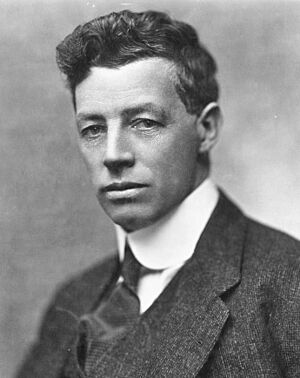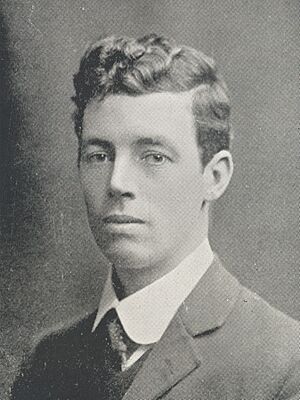Crawford Vaughan facts for kids
Quick facts for kids
Crawford Vaughan
|
|
|---|---|

Vaughan in 1910
|
|
| 27th Premier of South Australia | |
| In office 3 April 1915 – 14 July 1917 |
|
| Monarch | George V |
| Governor | Sir Henry Galway |
| Preceded by | Archibald Peake |
| Succeeded by | Archibald Peake |
| Leader of the Opposition in South Australia | |
| In office 14 July 1917 – 1917 |
|
| Preceded by | Archibald Peake |
| Succeeded by | Andrew Kirkpatrick |
| In office 26 July 1913 – 3 April 1915 |
|
| Preceded by | John Verran |
| Succeeded by | Archibald Peake |
| Leader of the United Labor Party | |
| In office 26 July 1913 – 12 February 1917 |
|
| Preceded by | John Verran |
| Succeeded by | Andrew Kirkpatrick |
| Personal details | |
| Born | 14 July 1874 Adelaide, South Australia, Australia |
| Died | 15 December 1947 (aged 73) Sydney, New South Wales, Australia |
| Political party | United Labor Party (1905–17) National Labor (1917–18) Independent (1918) |
Crawford Vaughan (born 14 July 1874 – died 15 December 1947) was an important Australian politician. He served as the Premier of South Australia from 1915 to 1917. A Premier is like the leader of the state government.
Vaughan was a member of the South Australian House of Assembly from 1905 to 1918. He first represented the area of Torrens and later Sturt. He was part of the United Labor Party. Before becoming Premier, he was the Treasurer, managing the state's money. He became the leader of the Labor Party in 1913 and then Premier after his party won the election in 1915.
His time as Premier was cut short because of a big disagreement during World War I. This was about whether Australia should force people to join the army (called conscription). Vaughan supported conscription, but many in his party did not. This led to a split in the Labor Party in 1917. Vaughan and others who supported conscription were removed from the party. He continued as Premier for a short time with a new party, but his government was soon defeated.
| Top - 0-9 A B C D E F G H I J K L M N O P Q R S T U V W X Y Z |
Early Life and Education
Crawford Vaughan was born in Adelaide, South Australia. His father, Alfred Vaughan, worked for the government as a photolithographer. Crawford went to public schools in Norwood and Marryatville. He also attended Prince Alfred College. After finishing school, he worked for a company called Elder, Smith & Co. Ltd for four years.
Starting in Politics
Vaughan first tried to enter politics in 1901 and 1903, but he wasn't successful. He finally won a seat in the South Australian House of Assembly in the 1905 state election. He was 30 years old at the time. He represented the United Labor Party.
In 1909, he became the party's whip, which is a role that helps keep party members organized. When John Verran led the Labor Party to victory in the 1910 election, Vaughan was given an important job: Treasurer. This meant he was in charge of the state's finances. After the Labor Party lost the 1912 election, John Verran resigned as leader. Crawford Vaughan was then chosen to lead the Labor Party in 1913.
Becoming Premier
In the 1915 state election, Vaughan and the Labor Party won against the Liberal Union government. This government was led by Archibald Peake. Labor won 26 out of 46 seats in the South Australian House of Assembly. At 40 years old, Vaughan became the youngest Premier in Australia at that time. His brother, John Vaughan, also became part of his government as the Attorney-General.
Key Achievements as Premier
Vaughan's government made several important changes:
- Education: They improved the education system. This included changing how the education department was run. They also made it compulsory for children to attend school for more years. Better facilities were provided for students with intellectual and physical disabilities.
- Women's Rights: Laws were passed to allow women to serve in the police force. Women could also become justices of the peace, which meant they could help with legal matters.
- Workers' Rights: The government made it easier for workers to use the arbitration system. This system helps solve disagreements between workers and employers. They also reduced the power of courts to punish trade unions.
- War Efforts: A wheat pool was created to manage wheat supplies during the war. They also started land and housing programs to help soldiers returning from the war.
- School Law: However, his government also passed a law that aimed to close Lutheran primary schools.
The Conscription Split
A major event during Vaughan's time as Premier was the debate over conscription. This was about whether Australia should force its citizens to join the army during World War I. Vaughan supported conscription, just like Prime Minister Billy Hughes. However, many people in the Labor Party were against it.
Because of his support for conscription, Crawford Vaughan resigned from the Labor Party in 1917. He then helped start a new party called the National Labor Party. Andrew Kirkpatrick took over as the leader of the official Labor Party. Vaughan continued to be Premier for a few more months, but his government was a minority government. This means they didn't have enough seats to easily pass laws. In 1917, his government was defeated in parliament over the conscription issue. Archibald Peake then became Premier again.
After the Premiership
After losing the premiership, Vaughan spent the last few months of his term on a speaking tour in the United States. He was invited by President Woodrow Wilson. He decided at the last minute to try and win his seat again in the 1918 election. He ran as an independent candidate, even though he was still overseas. However, he was not successful and left South Australian politics.
Life Outside Politics
Crawford Vaughan had a strong interest in writing. Before he entered politics, he was a freelance journalist. He even worked as the editor of a newspaper called Quiz for a while. Later in his life, he published two books: Golden Wattle Time (1942) and The Last of Captain Bligh (1950). He also wrote scripts for radio shows.
After leaving parliament, he moved to Sydney. There, he started several businesses. In his retirement, he spent a lot of time on his writing and literary interests. He passed away at his home in Sydney in 1947. The government of South Australia held a state funeral for him, which is a special ceremony to honor important people.
Family Life
In 1906, Crawford Vaughan married Evelyn Goode. She was the sister of one of his political colleagues, Clarence Goode. After Evelyn passed away in 1927, he remarried in 1934. His second wife was Millicent Preston-Stanley, who was famous for being the first woman elected to the Parliament of New South Wales.
Images for kids



